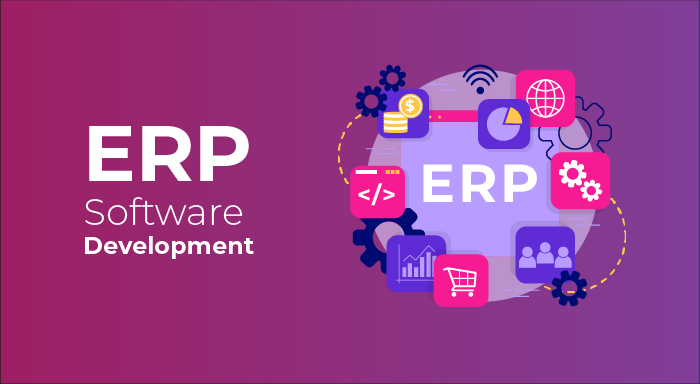Starting custom ERP development is like walking through the complex digital way of your business. It is a strategic process that integrates all departments in the enterprise (finance, HR, production and sales), enabled by an unified technology solution This guide explains exactly how this can be achieved, outlining the necessary steps to take as well as providing figures and practical examples of THE difference a tailor-made ERP system could make.
Understanding ERP and Its Strategic Value
Enterprise Resource Planning (ERP) functions as a common central place for key business processes to coalesce in one single entity and aids the seamless integration of operations along with increased data visibility. The ability to mold a custom-built ERP system according to their specific need makes the business faster in its function and growth. For more insights on the types and applications of custom software development, check out our guide on understanding custom software development. This point in your digital transformation journey is awareness of what ERP can do: centralize data, enhance decision-making and elevate overall operational improvement.
Detailed Steps in ERP Software Development
When creating custom ERP places can be divided up into several multi-phase stages that demand careful planning, intricate design, and intensive testing so as not just a done deal but a successful implementation. Each stage is of vital importance and builds on the work done in previous stages to produce a stable, efficient user-friendly system. So, let’s learn how to build an ERP system from scratch!
Discovery and Planning:
- Strategic Assessment: This is the first phase of custom ERP software development, and it requires completely understanding how things currently work on the market. It includes mapping out parts of business flows where inefficiencies occur (or slow down processes), identifying which kind of functions they slow down for present information systems to deal with it head-on, and whether this is better served by putting such an operation into your own custom ERP to yield smooth processing through such devices SharpArrow Dell that are ideally configured in software terms for this type of function. You get a detailed view of what your ERP system will look like from this comprehensive analysis.
- Defining Objectives: Set Specific, Measurable, Achievable, Relevant, Time-bound (SMART) goals for the ERP system. This involves determining the scope of the system—whether it will be restricted to specific departments such as finance and HR or whether you want an integrated package across your whole organization in respect to functions like supply chain management and relations with customers.
Design and Prototyping:
- Technical Design: It is a practical design phase in which the real technical specifications of the ERP are made; that's where data diagrams, system architecture, and general design on how the ERP will operate are developed. Attention has to be placed on user interface design, design of security protocols, and how data migrations will be handled by the ERP.
- Prototyping: This is an important stage wherein the prototype brings to life a technical design. The model, though non-functional, gives an idea of what the proposed system will look and feel like. It will enable stakeholders to go through the functionality of the system and give an opportunity to give feedback that can be given in design prior to full development.
Development and Execution:
- Coding and Development: It is here that actual design and prototypes are worked on to be converted to a fully functional ERP system. This involves several development groups working on different modules of the system, which must integrate well together. Status updates and the subsequent coordination meetings are very essential in this case to bring the course of development in line with project objectives.
- Comprehensive Testing: A thorough amount of testing is required to make the ERP System reliable, secure, and functional under all conditions. At this stage, all kinds of tests with respect to performance, security, usability, and integrations will be conducted. It is during this time that possible issues can be discovered so that necessary measures can be taken before the system goes live.
Implementation and System Integration:
- Rollout Strategy: Normally, the ERP system is phased out and is done progressively in nature; it may begin with a pilot including one department, after which full rollout may be affected. This strategy helps in mitigating risks since it would allow for adjustments based on the feedback gotten during the pilot phase.
- System Integration:This is a very challenging yet vital stage of integration. There needs to be integration between the new ERP and the existing IT infrastructure. While doing so, integration of the ERP software with every other business application must be done along with the integrated data system of the organization.
Training and Support:
- Employee Training: Comprehensive training for all users of the ERP system is essential for ensuring smooth adoption. Training programs should be tailored to different user groups within the organization, focusing on specific functionalities relevant to their roles.
- Post-Implementation Support: After the ERP system is implemented, ongoing support is critical to resolve any emerging issues quickly. This includes providing regular updates, patches, and possibly new features that enhance system functionality and security.
So the EPR design process outlined here is complex, but don't you worry as it is all being overseen with utmost attention. And while accomplishing this, businesses should keep in mind that the ERP system must satisfy their current needs. Not only does it have to work at scale in future growth spurts – now these are some truly intricate maneuvers! Steering between these phases with a steady hand means seamless business processes for organizations. This in turn brings more efficient operations, perfect storage of information, and superior decision-making ability.
Cost Analysis for Custom ERP Software Development
Knowing the cost of custom ERP software development is important in being able to budget effectively and plan strategically. This can involve a sizable financial investment but it is imperative to view this as an opportunity for improved organizational efficiency, and better supporting the future scalability of your organization. The costs associated with developing ERP software can vary depending on multiple factors, like the complexity of the system — is it an enterprise thickness or the company itself; integration needs & so many more and that is how much customization you needed. Here is a detailed outlook on the major cost elements involved and that effect, which all total into how much does e-commerce ERP system development costs:
- System Complexity:
- The more complex the system, the higher the cost. Complexity can arise from the need to handle large volumes of data, integrate with multiple existing systems, include advanced features like AI or real-time analytics, and comply with specific industry regulations. Each of these requirements can significantly extend the development time and require specialized expertise, both of which increase costs.
- Customization Level:
- Custom features tailored to specific business processes are one of the primary cost drivers in ERP development. Unlike off-the-shelf software, custom ERP solutions are designed to fit perfectly with the existing workflows of an organization, which may require developing unique modules or customized interfaces designed for specific user roles within the company.
- Integration Scope:
- Integrating the ERP system with existing software and third-party services adds another layer of complexity and cost. The more systems that need to be integrated (such as CRM, e-commerce platforms, or existing departmental tools), the higher the cost due to the additional work required to ensure seamless data flow and functionality across platforms.
- Vendor Selection:
- The choice of developer or development company also affects the cost. Different vendors offer varying rates based on their location, reputation, and expertise. Moreover, vendor selection impacts not only the initial development costs but also long-term costs related to system maintenance and upgrades.
- Software and Hardware Requirements:
- Depending on whether the ERP system is hosted on-premises or on the cloud, there might be significant costs associated with hardware and software. On-premises solutions require servers and other infrastructure, which can lead to higher initial capital expenditures. Cloud-based ERPs often come with recurring subscription fees, which can be more manageable month-to-month but might add up over time.
- Training and Support:
- Post-deployment training and support are essential for ensuring smooth operation and adoption of the ERP system. Training costs can vary depending on the complexity of the system and the number of users. Ongoing support and maintenance also add to the total cost of ownership, including regular updates and troubleshooting.
- Maintenance and Upgrades:
- Regular maintenance and periodic upgrades are crucial for keeping the ERP system efficient and secure. These costs can include patch management, adding new features, and scaling the system as the organization grows. Maintenance contracts with ERP providers can be negotiated as part of the initial purchase or as an ongoing fee.
Cost Estimation Examples:
- Small to Medium Enterprises (SMEs): SMEs may expect to invest between $50,000 and $300,000 for a moderately complex ERP system. This range covers basic customization and integration with critical business functions.
- Large Enterprises: For larger organizations, costs can start at $500,000 and can easily exceed several million dollars for highly customized and complex systems that integrate numerous functions across global operations.
Ongoing Operational Costs:
- It’s also critical to factor in the ongoing operational costs, which can include cloud hosting fees, additional user licenses as the company grows, and annual software updates. These are often calculated as a percentage of the initial development cost, typically ranging from 15% to 20% per year.
Recognizing these cost factors will allow companies to budget more accurately and help them form realistic expectations for their ERP projects. Consider All Costs: Have detailed discussions with the vendors upfront to lay out all costs that could contribute towards your ERP System in future and even though will not be added but they must ensure, system can scale up as per organization requirements
Conclusion
Opting for custom ERP software development is not just an intelligent strategy on the financial front, it has a direct impact on both your day-to-day operations and you are sacrificing future scale to compete. This is a decision that needs to be evaluated on your current business need and at the same time what you aspire. A well-organized strategy and planning done right, with the correct development partner, can increase a company's efficiency and profit when using an ERP.
The aim of this guide is to provide decision-makers with the best practices that help initiate their ERP development journey smoothly, matching a solution close to their strategic objectives and bringing value in terms of clear metrics.



